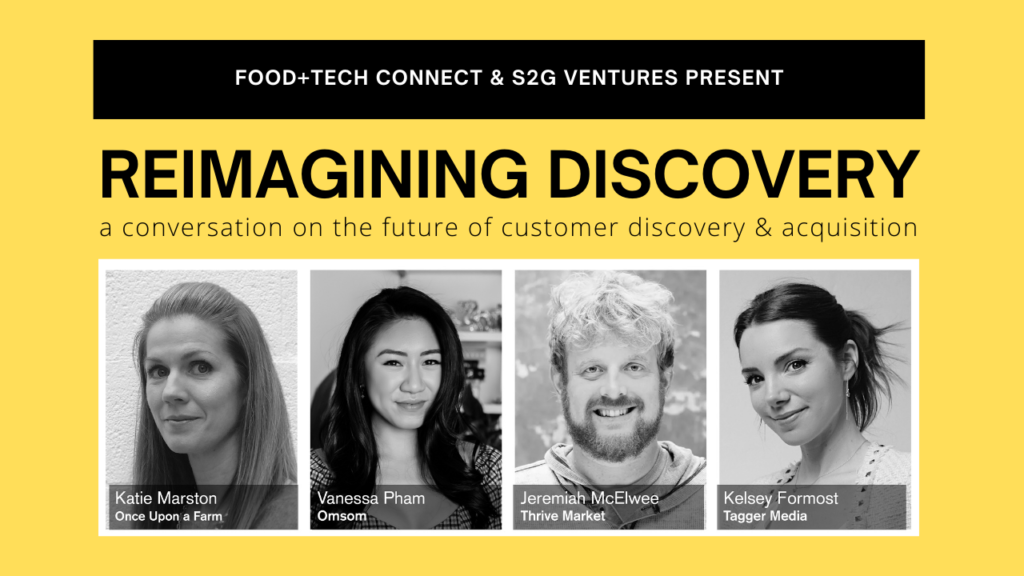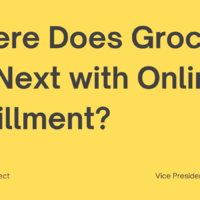
This is a guest post by Tonya Bakritzes, Senior Vice President of Marketing at S2G Ventures.
The unprecedented events of the last year forced food brands to quickly adapt to their customer’s needs and shopping behaviors, while also navigating a rapidly changing grocery retail landscape.
Last week, Food-Tech Connect and S2G hosted the second conversation in our Reimagining Food Retail Conversation Series to explore how emerging food brands are navigating this pivotal moment in time and growing their businesses through new approaches to customer discovery, acquisition and loyalty. We spoke with Vanessa Pham, Co-Founder at Omsom, Jeremiah McElwee, Chief Merchandising Officer at Thrive Market, Katie Marston, Chief Marketing Officer at Once Upon a Farm and Kelsey Formost, Director of Content Strategy at Tagger Media.
Omsom, Once Upon a Farm and Thrive Market all grew during 2020 and attributed their success to a common set of themes: purpose, customer-focus and community. Tagger has a wealth of data across social platforms and Kelsey Formost shared her perspective on the increasingly important role social and specifically social influencing is playing in the strategy of successful food brands. All the panelists shared actionable advice and specific techniques that emerging food brands can use to improve their marketing efforts.
The following are some of my key takeaways and favorite excerpts from the conversation.
Access the full video and join us for the rest of our Reimagining Food Retail Conversation Series where we’ll be talking with Walter Robb, former co-CEO of Whole Foods Market, Jody Kalmbach, Group Vice President, Product Experience at The Kroger Co., Birgit Cameron, Head of Patagonia Provisions and Errol Schweizer, Host of The Checkout Podcast, and more about reimagining retail for resilience and to better serve all stakeholders.
Purpose, Allyship & Community Were Keys to Growth in 2020
“This is a really challenging time. Knowing who you are and what you’re trying to do in the world allows you to react and respond quickly, both to serve your customers, but also to do greater good in the world.”
– Jeremiah McElwee, Thrive Market
As a result of Covid, consumer interest in healthier food choices was amplified. Farmers, producers and food workers became essential workers. The spotlight placed on our food system raised consumer awareness of a complex set of questions about our food, beyond just price and taste, to animal welfare, source and authenticity, environmental impact, and the working conditions and compensation of employees that produced it. Transparency has become critically important.
Our panelists shared their perspectives on the importance of being very clear in your brand’s mission and how that should direct marketing and communications but more broadly how it gave their companies a north star by which to make critical business decisions. For Once Upon a Farm, that meant sending the proceeds of their new Farmer Jen’s Sweet Potato Pie product to Save the Children in support of their emergency food relief efforts. Vanessa shared that Omsom’s mission to honor and celebrate Asian American communities inspired them to partner with iconic chefs of the backgrounds of each cuisine they represent to showcase their flavors and integrate them into the product development process in return for a portion of sales into the future. Jeremiah shared that Thrive’s core mission and belief structure afforded them the opportunity to create a COVID-19 relief fund that has since grown to $3 million, and use the proceeds to give away free groceries, stipends and memberships to hundreds of families across the U.S. Once Upon a Farm, Omsom and Thrive Market all experienced significant growth in 2020 demonstrating that customers value brands that take action to live up to their values and want to be associated with that greater purpose.
Customer-Focus: Being an Ally to Your Customer Builds Loyalty
“In 2020, it was about recognizing the need for seamless integration into her life, versus selling. Our customers are very busy moms that were all of a sudden dealing with work at home, school, intermittent childcare at best. We considered it our jobs to make things easier and best in class for her, from where she was going to learn about us, purchase us and try us.”
– Katie Marston, Once Upon a Farm
When Covid shelter-in-place restrictions came into effect, a series of events changed customer’s lives in big and small ways. It’s no secret that more people have been shopping online during COVID. As a result, online grocery penetration rose to 8% in 2020, up from 4% last year. Beyond shopping, people are eating and cooking from home more than ever before, many are juggling remote work and virtual school, navigating the challenges of essential work or dealing with layoffs.
Our panelists touched on the need for successful brands to play a supportive role in customer’s lives more than ever during this time. Katie shared that Once Upon a Farm started with a focus on their loyal customers. She said, “We went right to the source and concentrated on our current customers over new customer acquisition and worked with our retailers on the retail.com platforms, our own e-commerce, rethinking trade programs and stacking influencers.” Kelsey shared her perspective on why influencer marketing is such a valuable tactic for reaching customers where they are spending time. She cited two facts – that the amount of time we spend on social media doubled in 2020 and that influencer marketing campaigns saw an 11 times higher ROI, as compared to traditional display ads. Thrive Market has a very curated model and small number of SKUs as compared to the average grocery store, so one way they are constantly adapting to customer needs is through the product mix. Jeremiah said, ”It’s first and foremost, choosing those brands and finding those partners and finding really compelling, amazing brands and products that we can bring to our members that we know they’ll want.”
Download S2G Venture’ Future of Food: Through The Lens of Retail Report to understand how innovations in content, commerce and community might transform the shape of the future of food retail.
Community: Shifting IRL Marketing to Digital to Acquire Customers and Build Community
“If you don’t have a lot of resources, do not try to talk to a wide audience, be very clear about who you’re speaking to, know what they care about, know their values, know what channels they use, know how they identify and what perspectives they hold. And I think if you can focus on them and get that one community to really care about you, you’re at a great starting point to then have them reach out to their kind of peers around them, and halo out to broader new audiences over time.”
– Vanessa Pham, Omsom
With so many people ordering groceries online, demos and other tried and true in-store marketing techniques weren’t possible. Brands turned to digital channels to acquire customers and build a following for their products.
Our panelists shared that to build a loyal customer base it is essential to start with a small, targeted audience and not try to appeal to everyone or risk appealing to no one. Once brands have a core group of fiercely loyal customers those advocates can reach adjacent audiences. Vanessa cited RX Bar and Halo Top as examples of brands who started with a niche community of weightlifters and bodybuilders, credible sources in health and wellness, and leveraged their endorsement to expand to a wider audience.
We covered a variety of digital tactics that Omsom, Once Upon A Farm and Thrive Market are using to drive acquisition and build communities. Kelsey noted that social influencer marketing is valuable because it allows you to “reach people who are already predisposed to like you, even if you are a small brand.”
Katie shared that search has been a valuable technique for acquisition and that they are testing and iterating on their strategy to find specific terms that indicate customer affinity to their products. As an example she shared that, “We found that someone shopping for kombucha has a high affinity and conversion to buying our types of cold-pressed fruit and veggie blends.” These types of customer insights can be applied to other channels as well.
Jeremiah spoke about how Thrive’s is serving their members online through product discovery. Their highly curated product mix allows for a simple shopping experience and they continue to invest in optimization of their website’s discovery features. He also shared that email has been a high performing channel to drive awareness of new products with their members.
Vanessa noted that Omsom’s marketing strategy balances grassroots brand building with paid advertising. She said, “Our sweet spot is actually a hybrid of the two. Where we invest in super high quality and intentional community building.”
Food Brands Build Trust through Repetition & Consistent Messaging Across Channels
“There’s no perfect attribution model, no algorithm that you can say, ‘This goes to this to this.’ I wish. Digital has helped, but it is all about seeing do all tides rise? And what we saw is when we amplified a really wonderful message about the strength of our brand, we saw even our e-commerce rose. We also saw our retail sales rise. So that halo effect is real. And it’s just about remembering that it is an omni-channel world.”
– Katie Marston, Once Upon a Farm
When the panic buying of March 2020 happened, retailers started rethinking what to put on their shelves and they began prioritizing the essentials and really larger established brands over smaller emerging ones. This caused emerging brands to reassess their strategies for discovery and acquisition, including how to balance investment in marketing to support retail channels versus launching or growing a direct to consumer channel which has a higher minimum price point. For small brands with a minimal marketing budgets, it can be difficult to prioritize and measure the success of their efforts.
Our panelists shared practical advice on how emerging food brands should think about their marketing investments in the light of the ever growing number of commerce options available to customers. Katie reminded us that campaigns for one channel, like D2C, can ultimately lead to sales through another channel, retail. Kelsey shared that, “repetition is recognition and recognition is trust. And you can’t have sales without trust no matter if it’s retail, D2C. You have to show up enough times for a consumer, especially in the absence of a physical trial, enough times for them to know you, like you, and trust you.” Vanessa shared advice on the three areas that food brands need to over invest in: content creation, to communicate what the food looks and might taste like; word of mouth, through product seeding and speaking to the values that resonate with your audience; and communicating a strong brand story to the press who are trusted influencers in food.
Live Selling is the Next Frontier in E-Commerce
“Live selling was a $60 billion industry last year, but the U.S. only accounted for $1 billion of that. We are way behind the rest of the world, which is why we at Tagger are predicting this is going to be the next frontier.”
– Kelsey Formost, Tagger Media
The top question from our community during the session was about live selling, a soon to launch offering from Instagram and Youtube that will allow brands to sell their products live, similar to QVC. Kelsey shares her perspective on the market potential for this new online social commerce channel.
Our conversation was a part of our Reimagining Food Retail Conversation Series that was inspired by S2G’s recently released Future of Food: Through the Lens of Retail Report as a framework. The series will examine how innovations in content, commerce and community might transform the shape of the future of food retail.
Join us for future Redesigning Retail conversations here.
 Tonya Bakritzes is SVP of Marketing at S2G Ventures where she oversees the fund’s brand strategy, marketing and communications and provides strategic guidance to the fund’s portfolio companies.
Tonya Bakritzes is SVP of Marketing at S2G Ventures where she oversees the fund’s brand strategy, marketing and communications and provides strategic guidance to the fund’s portfolio companies.
She has over 20 years of experience working in the technology industry delivering large-scale digital solutions across a variety of industries including Financial Services, Energy, Education and Travel & Hospitality. Her past work has ranged from business planning, consumer research & strategy development to design, build and support of enterprise-scale platforms to marketing campaign planning, execution, and optimization. Tonya has over 15 years of experience working in digital agencies and consultancies as a strategic advisor for clients and 5 years delivering digital programs at J.P. Morgan Chase in the Treasury Services division.





